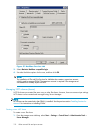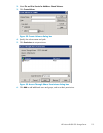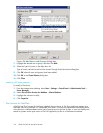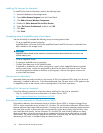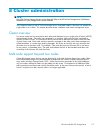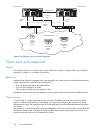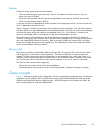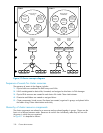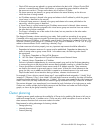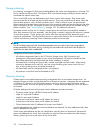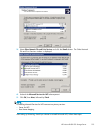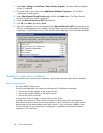Failover
Failover of clus
ter groups and resources happens:
• When a node hosting the group becomes inactive. A shutdown of cluster service or a loss of
power can cause a failover.
• When all of the resources within the group are dependent on one resource, and that resource fails.
• When an ad minis
trator forces a failover.
A resource and all of its dependencies must be located in the same group so that if a resource fails over,
all of its dependent resources fail over.
When a resource is failed over, the cluster service performs certain procedures. First, all of the resources
are taken offli
ne in an order defined by the resource dependencies. Seco ndly, the cluster service attempts
to transfer the group to the next n ode on the preferred owner’s list. If the transfer is successful, the
resources are brought online in accordance with the resource dependency structure.
The system failover policy defines how the cluster detects and responds to the failure of individual
resources in
the group. After a failover o ccurs and the cluster is brought back to its original state, failback
can occur aut
omatically based on the policy. After a previously failed node comes online, the cluster
servicecanfailbackthegroupstotheoriginalhost.Thefailbackpolicymustbesetbeforethefailover
occurs so that failback works as intended.
Quorum disk
Each cluster must have a shared disk called the Quorum disk. This physical disk in the common cluster
disk array plays a critical role in cluster operations. The Quorum disk offers a means of persistent
storage. The disk must provide physical storage that can be accessed by any node in the cluster. If a
node has control of the quorum resource upon startup, it can initiate the cluster. In addition, if the node
can communicate with the node that owns the quorum resource, it can join or remain in the cluster.
The Quorum disk maintains data integrity by:
• Storing the most current version of the cluster database
• Guaranteeing that only one set of active communicating nodes is allowed to operate as a cluster
Cluster c
oncepts
Figure 5
7 illustrates a typical cluster configuration with the corresponding storage elements. The diagram
progres
ses from the physical disks to the file shares, showing the relationship between both the cluster
elements and the physical devices underlying them. While the diagram only illustrates two nodes, the
same concepts apply for multi-node deployments.
HPProLiantDL380G5StorageServer 119




